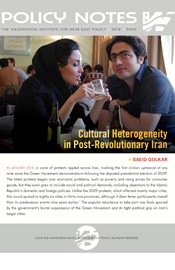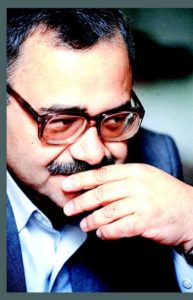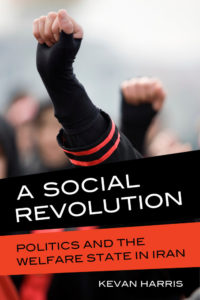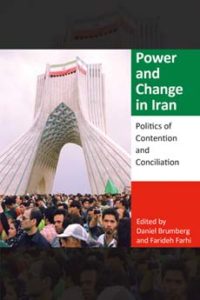All this week panicked Iranians have gathered in throngs outside banks and other financial businesses hoping to buy dollars, as the government seeks to head off a collapse in the rial, the national currency, the New York Times reports.
Iran’s rial weakened to a record low of 60,000 to the dollar on the free market this week, according to Reuters. That marked a 50 percent drop in the rial’s value from a year ago, VOA adds. The faster the rial falls, the weaker the regime becomes, say Richard Goldberg and Saeed Ghasseminejad of the Foundation for Defense of Democracies. The crisis provides an opportunity to isolate Iran’s clerical leaders and empower its people, they write for the Hill.
“The economic malaise is a consequence of the political malaise in the country,” according to Ali Ansari, the founding director of the Institute for Iranian Studies at the University of St Andrews. “A succession of leaders have promised to be able to reform this but have almost all come unstuck when faced with the reactionary deep state that exists in Iran.”
 Officials in President Hassan Rouhani’s government say there’s no economic rationale for the currency slide, and have suggested conservative opponents are fueling it to discredit the administration, Bloomberg adds.
Officials in President Hassan Rouhani’s government say there’s no economic rationale for the currency slide, and have suggested conservative opponents are fueling it to discredit the administration, Bloomberg adds.
“One of Rouhani’s main first-term achievements was to stabilize the foreign-exchange market even before his second achievement, the nuclear deal, was concluded,” said Ali Vaez, senior Iran analyst at International Crisis Group. “Now both are crumbling. Whether Rouhani’s rivals are contributing to the fiasco or not, they are benefiting from it.”
 Abdul-Al Duraqi (left), a poet and activist from the Ahwazi minority in Iran, was arrested during the most recent protests in the city of Ahwaz, with the overall number of arrests reaching the 400 mark, the UN reports. The Iranian government is suspected of torture and has consistently refused fair trials and due process in many of these cases. Al Duraqi’s case is a classic illustration of the disproportionate use of force by the Iranian regime against political dissidents in the country.
Abdul-Al Duraqi (left), a poet and activist from the Ahwazi minority in Iran, was arrested during the most recent protests in the city of Ahwaz, with the overall number of arrests reaching the 400 mark, the UN reports. The Iranian government is suspected of torture and has consistently refused fair trials and due process in many of these cases. Al Duraqi’s case is a classic illustration of the disproportionate use of force by the Iranian regime against political dissidents in the country.
 “The poor and the minorities are the victims of capital punishment in Iran,” according to Roya Boroumand of the Abdorrahman Boroumand Center, a Washington-based non-profit organization promoting human rights and democracy in Iran. “I can tell you from experience that they live in terrible conditions,” she adds.
“The poor and the minorities are the victims of capital punishment in Iran,” according to Roya Boroumand of the Abdorrahman Boroumand Center, a Washington-based non-profit organization promoting human rights and democracy in Iran. “I can tell you from experience that they live in terrible conditions,” she adds.
Shirin Ebadi, Iran’s Nobel Peace Prize-winning human rights lawyer, has represented her country’s dissidents in the Islamic Republic’s corrupt courts, writes Bloomberg’s Eli Lake:
 She spoke out for the rights of women, minorities and students abroad. But she never called for the end of the regime she was fighting to reform. Until now…. For Ebadi the means of ending Iranian tyranny should be a U.N.-monitored referendum on the constitution that proposes a basic change: the elimination of the unelected office of supreme leader. The Iranian people, she said, “want to change our regime, by changing our constitution to a secular constitution based on the universal declaration of human rights.”
She spoke out for the rights of women, minorities and students abroad. But she never called for the end of the regime she was fighting to reform. Until now…. For Ebadi the means of ending Iranian tyranny should be a U.N.-monitored referendum on the constitution that proposes a basic change: the elimination of the unelected office of supreme leader. The Iranian people, she said, “want to change our regime, by changing our constitution to a secular constitution based on the universal declaration of human rights.”
“Reform is useless in Iran,” said Ebadi. “The Iranian people are very dissatisfied with their current government. They have reached the point and realized this system is not reformable.”
Ebadi has not been without her critics, including Iran analyst Vali Nasr, a contributor to the National Endowment for Democracy’s Journal of Democracy.
“Ebadi’s confused rendition of Iranian history, which vacillates between celebrating the revolution and condemning its consequences, makes it difficult to regard her as a symbol of democracy,” he wrote for the New Republic. “Still, it is possible to look beyond her perplexing tentativeness and regard her story as emblematic of the paradox of a revolution that mobilized, educated, and ultimately frustrated Iranian women.”
Ebadi’s radicalism, along with the mass demonstrations that began at the end of December, is a powerful rebuke to the foreign policy consensus among many Western progressives who still pine for Iran’s president, Hassan Rouhani, to deliver on the reforms he promised in his 2013 and 2017 campaigns, Lake adds.
Pessimism over prospects for incremental reform is also a feature of Misagh Parsa’s Democracy in Iran: Why It Failed and How It Might Succeed, which weighs the factors that lead to democratization via revolution, versus democratization via reform, notes Luma Simms, a fellow at the Ethics and Public Policy Center. The choice between reform and revolution, Parsa suggests, may depend on “the nature of the conflicts, the historical possibilities, and the available options. The conditions and variables examined in this work point conclusively in one direction—that is, that a route to Iran’s democratization through reform is not available,” Simms writes for Law and Liberty.
 This past year’s upheaval came after years of civil stagnation, notes Saeed Peyvandi, professor of sociology from Paris 13 University. “The defeat in 2009 of the Green Revolution, which brought millions to the streets, was a hard blow to civil rights activists and provided an excuse for the regime to suppress civil society,” Peyvandi (left) told Radio Farda:
This past year’s upheaval came after years of civil stagnation, notes Saeed Peyvandi, professor of sociology from Paris 13 University. “The defeat in 2009 of the Green Revolution, which brought millions to the streets, was a hard blow to civil rights activists and provided an excuse for the regime to suppress civil society,” Peyvandi (left) told Radio Farda:
During the 1990s and 2000s, the government largely saw civil society organizations as threats against Islamic rule. They view civic engagement as something negative …The intelligence and security forces’ ideal society is one without any organization, except of course for gatherings…which they view as a referendum in their favor. Any other mass gatherings or demonstrations are always illegal, thus suppressing all NGOs, independent political parties, and trade unions.
 In addition to economic fissure, a growing sociocultural gap – religious-Hezbollahi versus hybrid-postmodern – constitutes a central fault line in the country, says analyst Saeid Golkar. The countervailing emergence of the hybrid-postmodern bloc, and its acceptance among a majority of Iranians, can be seen to reflect the regime’s failure to build a pure Islamic society and culture embraced by all citizens, he writes in Cultural Heterogeneity In Post-Revolutionary Iran, published by The Washington Institute for Near East Policy.
In addition to economic fissure, a growing sociocultural gap – religious-Hezbollahi versus hybrid-postmodern – constitutes a central fault line in the country, says analyst Saeid Golkar. The countervailing emergence of the hybrid-postmodern bloc, and its acceptance among a majority of Iranians, can be seen to reflect the regime’s failure to build a pure Islamic society and culture embraced by all citizens, he writes in Cultural Heterogeneity In Post-Revolutionary Iran, published by The Washington Institute for Near East Policy.
Those hoping for radical reform in the near future will likely be disappointed, argues analyst Anagha Lokhande. “Khamenei and his establishment’s power is deeply entrenched and often suppresses opposition through violence, discouraging Iran’s middle class and intellectual community from mobilizing public opposition,” she writes for the Brown Political Review. But the recent protests “have sown the seeds for genuine reform … [and] signaled the changing politics and ideals of ordinary Iranians.”
 The opposition’s political discourse has recently been influenced by a new breed of liberal democratic intellectuals, such as Hossein Bashiriyeh (left). He has been described as “one of the key political thinkers of post-revolutionary Iran … [and] very influential in introducing democratic theories and ideas to a generation of Iranian intellectuals and political figures who later played significant roles in the democratic and reform movement.”
The opposition’s political discourse has recently been influenced by a new breed of liberal democratic intellectuals, such as Hossein Bashiriyeh (left). He has been described as “one of the key political thinkers of post-revolutionary Iran … [and] very influential in introducing democratic theories and ideas to a generation of Iranian intellectuals and political figures who later played significant roles in the democratic and reform movement.”
Bashiriyeh remains exiled from his homeland because “his ties to U.S. institutions and the Iranian reformist movement made him ‘undesirable’ to the conservative ruling establishment,” according to Mehrzad Boroujerdi, the chair of Syracuse University’s Middle Eastern studies program. Furthermore, his “association with democratic organizations in Washington was particularly frowned on by the government.”
The Islamic Republic, as a semi-authoritarian regime, systematically turns off the public sphere’s lights, weakens the civil institutions, controls and pressures every single self-organized group or community (even apolitical and peaceful communities like Sufis and Bahais), dominates professional syndicates and associations and kills the possibility of forming independent effective social networks, notes Qom-trained Shiite theologian Mehdi Khalaji (right), the Libitzky Family Fellow at The Washington Institute.
(right), the Libitzky Family Fellow at The Washington Institute.
“Considering the weakness of civil society and clergy’s refusal to support subversive initiatives, protests may continue but probably remain scattered, leaderless, without a precise plan or vision,” he contends. “With neither reform nor revolution likely to succeed in the Islamic Republic in the near future, its essential flaws may become fatal. The Shiite religious class is struggling to maintain its discriminatory anti-liberal and anti-democratic privileges and positions.”
Tipping point
 The recent protests were a tipping point created by 30 years of economic mismanagement, corruption, cronyism, and increased pressure due to sanctions, says Stanford University’s Abbas Milani. “So it is to me an indication of the level of despair,” he said. “Where in places never before the centers of discontent, you are seeing massive demonstrations, either in size or in the ferocity of the slogans,” he told Judy Woodruff of PBS NewsHour:
The recent protests were a tipping point created by 30 years of economic mismanagement, corruption, cronyism, and increased pressure due to sanctions, says Stanford University’s Abbas Milani. “So it is to me an indication of the level of despair,” he said. “Where in places never before the centers of discontent, you are seeing massive demonstrations, either in size or in the ferocity of the slogans,” he told Judy Woodruff of PBS NewsHour:
Only those blind to realities on the ground in Iran are blindsided by the wrath of the Iranian people, he writes in an article for NPR. The unexpected origins of these protests due to “a surprisingly large number of demonstrators [coming] from the ranks of the working classes, whose support the regime had counted on for all of its tenure,” he adds in an op-ed piece in NY Daily News.

MEI
The protests proved the assumptions pushed by Tehran’s apologists to be totally devoid of any bearing in reality, argues Prof. Ivan Sascha Sheehan is the incoming Executive Director of the School of Public & International Affairs at the University of Baltimore. His observations in a recent issue of Modern Diplomacy speak to three fundamental truths related to obtaining freedom and liberty in Iran:
- First, the overthrow of the ruling religious dictatorship is an imperative.
- Second, the regime’s overthrow is within reach.
- And third, a democratic alternative and an organized resistance exists which is capable of toppling the theocracy in Iran.
 Intermediate institutions are critical to the Islamic Republic’s legitimacy, according to Kevan Harris, Assistant Professor of Sociology at the University of California, Los Angeles, and author of, A Social Revolution: Politics and the Welfare State in Iran.
Intermediate institutions are critical to the Islamic Republic’s legitimacy, according to Kevan Harris, Assistant Professor of Sociology at the University of California, Los Angeles, and author of, A Social Revolution: Politics and the Welfare State in Iran.
“You can’t explain mass politics in Iran through single anecdotal stories of clientelism. We get surprises on a regular basis in Iranian politics,” he tells Marc Lynch’s POMEPS Podcast. “I think we need to look at the middle institutions, a meso-level understanding of Iran and many other organizations.”
Boomerang effect
In a political system like Iran, efforts to centralize power can have a boomerang effect, leading to more vibrant struggles against repression, argues Daniel Brumberg, an Associate Professor at the Department of Government and Director of the Democracy and Governance Studies at Georgetown University.
The timing of recent Saudi announcements of incremental reform was perfect — if inflaming Iran’s civil society was the goal, the New York Times reports.
 “When I see reforms in Saudi Arabia, I am doubly elated: happy for Saudi society and women especially,” said Mariam Memarsadeghi, a co-founder of Tavaana, a website dedicated to civic education in Iran, “but also thrilled that the Iranian regime’s false moral superiority is punctured, that the Iranian regime’s laws and actions against women’s rights are made to look backward even by a country long seen as the region’s most backward.”
“When I see reforms in Saudi Arabia, I am doubly elated: happy for Saudi society and women especially,” said Mariam Memarsadeghi, a co-founder of Tavaana, a website dedicated to civic education in Iran, “but also thrilled that the Iranian regime’s false moral superiority is punctured, that the Iranian regime’s laws and actions against women’s rights are made to look backward even by a country long seen as the region’s most backward.”
Prior to Rouhani’s election, “the arena of political participation and debate not only came under the thumb of hard-line conservative politicians, clerics, and newspaper columnists but was increasingly dominated by a new generation of Revolutionary Guards (IRGC) and their affiliated troops—the Basij Resistance Force,” note analysts Daniel Brumberg and Farideh Farhi.
“With Iran’s political system seemingly shorn of the quasi-pluralistic institutional mechanisms that had long supported a complex system of state-controlled political competition and conflict management,” they write in Power and Change in Iran: Politics of Contention and Conciliation.
 For some observers, they add, “the Iranian state had become a wholly owned subsidiary of a new generation of IRGC leaders and the institution they headed. Allied with an ultra hard-line wing of Parliament’s conservative “principlist ” faction, this new cadre of apparatchiks, paranoid ideologues, and allied businessmen had seemingly not only suffocated independent political life and competition; [but also] captured a wide number of institutions.”
For some observers, they add, “the Iranian state had become a wholly owned subsidiary of a new generation of IRGC leaders and the institution they headed. Allied with an ultra hard-line wing of Parliament’s conservative “principlist ” faction, this new cadre of apparatchiks, paranoid ideologues, and allied businessmen had seemingly not only suffocated independent political life and competition; [but also] captured a wide number of institutions.”
“Even if—as seems likely—hard-liners try to thwart the cautious bid of Rouhani and his allies to reopen the political, cultural, and economic fields,” Brumberg and Farhi add, “the deeper structural forces that gave rise to these pluralizing efforts will shape Iran’s politics for many years to come, creating a complex interplay between dynamics of sociopolitical opening and contraction.”
For now Ebadi thinks it is important for the U.S. to establish a channel to the legitimate and independent Iranian opposition… She warned the regime had established all kinds of fake nongovernment organizations and groups overseas that appear independent, but really do the government’s bidding, such as the National Iranian American Council, or NIAC, Bloomberg’s Lake adds:
One example is a group known as the Organization for Defending Victims of Violence, which has represented Iranian civil society at the annual meetings of the U.N. Human Rights Council. In 2011, the Center for Human Rights in Iran described it as “an NGO that in spite of its name, has not done anything during the session to defend the rights of Iranian victims of violence.” Indeed, Ebadi told me that its former executive director, Alireza Taheri, was her interrogator when she was arrested in 2005.








